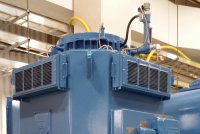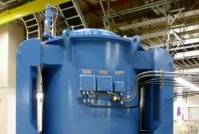The influent pump station collects raw sewage and pumps it two miles south to the wastewater treatment plant, which is built at an elevation approximately 235 feet higher than the IPS. With a 235-foot lift, which is considered a “high lift” for sewage pumps, the influent pump station installed four pairs of vertical non-clog sewage pumps to run in series arrangement. Though the pump station is designed to accommodate six pairs of pumps in its dry pit, the eight Fairbanks Morse pumps successfully transport approximately 17 million gallons of sewage to the wastewater treatment plant per day.
Each pair of pumps works in series at different elevations; that is to say, one pump, the first stage pump at elevation 57, pumps into the second pump at elevation 85. The sum total of those two pumps provides enough energy to push the raw sewage through the pipes to the wastewater treatment plant. Each pump sits on a pedestal and utilizes a 28 foot-long drive shaft to connect to the motor, which is not directly mounted on the pumps, but installed on the floor directly above. So for the pumps at elevation 57, the 700HP motors are installed on elevation 85; and for the pumps on elevation 85, the 1500HP motors are installed at elevation 109.
These pumps are all equipped with variable frequency drives, which, while VFDs typically ramp pumps down gradually to avoid surge, would not be able to do so during a power outage.
The pumps were driven by 700- and 1500-horsepower motors, which had been custom-manufactured by WEG Electric Corp. The initial motors had been designed with a considerable amount of inertia, with the 1500HP motors offering 15,000 lbs. ft.2 of inertia. However, hydraulic modeling and surge analysis determined that 51,500 lbs. ft.2 would be needed to offset the system surge. 51,500 lbs. ft.2 was a substantial amount of inertia, and it was questionable whether new motors could be manufactured to support the station’s new requirement.
The engineers at WEG Electric Corp. accepted the challenge and figured out a way to build a 1500HP motor with 51,500 lbs. ft.2 of inertia and a 700HP motor with 11,467 lbs. ft.2 of inertia. After spending several months scrutinizing system specs and working their way through the engineering and design process, the engineers at WEG proposed the satisfactory solution to the customer.






